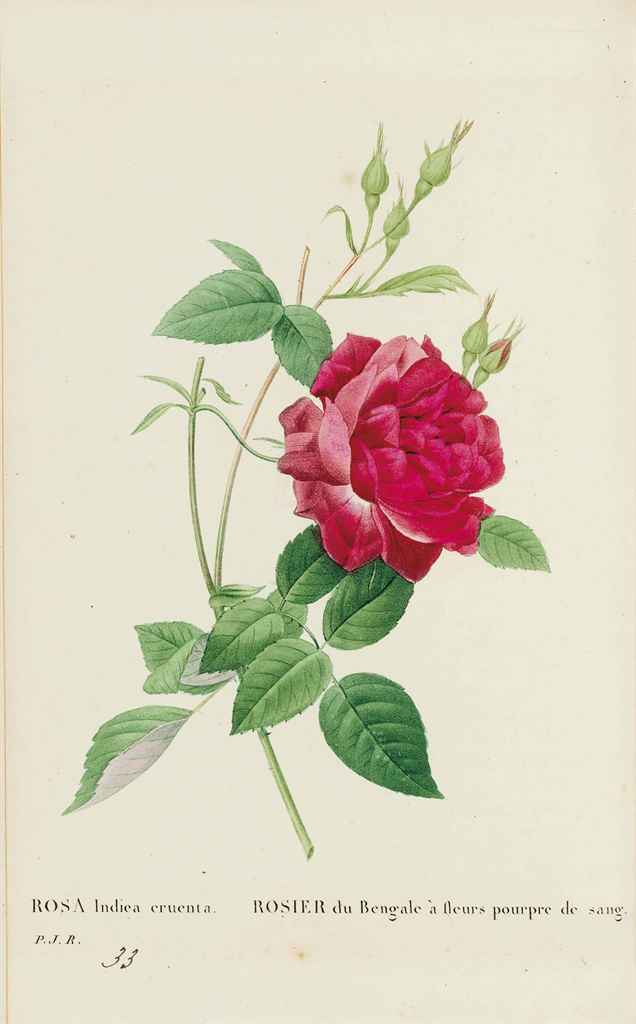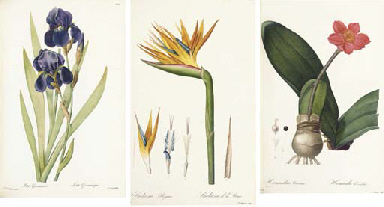REDOUTÉ, PIERRE-JOSEPH and CLAUDE ANTOINE THORY. Les Roses. Paris: Firmin Didot 1817-1824. 3 volumes, folio, 357 x 266mm., contemporary red half morocco by Ch. Blaise (stamped in gilt at foot of vol.I), spines in five compartments with false raised bands, the bands decorated with elegant gilt floral sprays, the second and fourth compartments lettered in gilt, the others tooled in blind, very light scuffing to extremities, light spotting to portrait, titles of vols. I and II and some text leaves, particularly in vol.I. FIRST EDITION, WITH THE PLATES IN TWO STATES. Half-title, engraved portrait of Redouté by C.S.Pradier after Gerard. Floral wreath and 169 stipple-engraved plates in two states, printed in colors and finished by hand, and in black on ochre paper, by Langlois, Chapuy and others after Redouté, printed by Rémond. A fine clean copy of Redouté's most famous work, in one of its most desirable states. Les Roses , with its combination of Redouté's plates and Thory's text, remains not only a great artistic achievement, but also a valuable scientific record. Lawalrée descibes the text as being "of outstanding importance to both botanists and horticulturalists". Its author, Thory, was an ardent botanist with his own collection of roses, who came to live on an estate neighbouring Redouté's own soon after 1814. Their celebration of the Rose describes many forerunners of today's flowers, and includes details of a number of species and cultivars that have since disappeared. The specimens described were gathered from various gardens in and around Paris, and included examples from Malmaison as well as Thory's own collection. The expense of the publishing enterprise was enormous, by 1822 Redouté's financial position was perilous, and, despite help from various wealthy aristocratic patrons and a measure of official recognition, was to remain so until his death in 1840. In an effort to generate as much interest as possible Les Roses was offered in various forms (as with many French 'collector's' books of the period): large folio with colored plates; large folio with the plates in two states; large folio with the text on ochre paper and the plates in two states; folio with colored plates and (as here) folio with the plates in two states. The black impressions of the plates initially served a practical purpose: "It was discovered by English printers that stipple engravings printed most successfully from plates that had been well used. A number of black impressions were run off to take the sharpness off the plate. Redouté's printers also took some black impressions from plates for both the Liliacées and the Roses ... the black impressions are always printed on paper with a strong ochre-yellow tint... Since black has a much greater force than the delicate colored inks washed with thin watercolor that Redouté normally used, black impressions on reflective white paper would have produced prints with grossly exaggerated tonal contrasts. By using paper devoid of brilliance, he was able to subdue that contrast and produce black prints that enabled the reader to appreciate the purity of his engravers' stipple and roulette technique". (G. Bridson & D. Wendel, Printmaking in the service of Botany Pittsburgh: Hunt Institute, 1986. no.25). Dunthorne 232; Great Flower Books p.71; Cleveland Collections (Kent, Ohio: 1992) 807; A. Lawalrée Les Roses facsimile edition, with commentary (Antwerp 1978); I. MacPhail. 'Books Illustrated by Redouté' in G. H. M. Lawrence, A Catalogue of Redoutéana exhibited at the Hunt Botanical Library (Pittsburgh: 1963) 19; Nissen BBI 1599; Stafleu & Cowan TL2 8748. Provenance : Caroline de Selys Longschamps, inscription on front free endpaper of vol.I: 'Caroline de Selys Longchamps donné par Grand merê, le 1 . Janvier 1854'. (3)
REDOUTÉ, PIERRE-JOSEPH and CLAUDE ANTOINE THORY. Les Roses. Paris: Firmin Didot 1817-1824. 3 volumes, folio, 357 x 266mm., contemporary red half morocco by Ch. Blaise (stamped in gilt at foot of vol.I), spines in five compartments with false raised bands, the bands decorated with elegant gilt floral sprays, the second and fourth compartments lettered in gilt, the others tooled in blind, very light scuffing to extremities, light spotting to portrait, titles of vols. I and II and some text leaves, particularly in vol.I. FIRST EDITION, WITH THE PLATES IN TWO STATES. Half-title, engraved portrait of Redouté by C.S.Pradier after Gerard. Floral wreath and 169 stipple-engraved plates in two states, printed in colors and finished by hand, and in black on ochre paper, by Langlois, Chapuy and others after Redouté, printed by Rémond. A fine clean copy of Redouté's most famous work, in one of its most desirable states. Les Roses , with its combination of Redouté's plates and Thory's text, remains not only a great artistic achievement, but also a valuable scientific record. Lawalrée descibes the text as being "of outstanding importance to both botanists and horticulturalists". Its author, Thory, was an ardent botanist with his own collection of roses, who came to live on an estate neighbouring Redouté's own soon after 1814. Their celebration of the Rose describes many forerunners of today's flowers, and includes details of a number of species and cultivars that have since disappeared. The specimens described were gathered from various gardens in and around Paris, and included examples from Malmaison as well as Thory's own collection. The expense of the publishing enterprise was enormous, by 1822 Redouté's financial position was perilous, and, despite help from various wealthy aristocratic patrons and a measure of official recognition, was to remain so until his death in 1840. In an effort to generate as much interest as possible Les Roses was offered in various forms (as with many French 'collector's' books of the period): large folio with colored plates; large folio with the plates in two states; large folio with the text on ochre paper and the plates in two states; folio with colored plates and (as here) folio with the plates in two states. The black impressions of the plates initially served a practical purpose: "It was discovered by English printers that stipple engravings printed most successfully from plates that had been well used. A number of black impressions were run off to take the sharpness off the plate. Redouté's printers also took some black impressions from plates for both the Liliacées and the Roses ... the black impressions are always printed on paper with a strong ochre-yellow tint... Since black has a much greater force than the delicate colored inks washed with thin watercolor that Redouté normally used, black impressions on reflective white paper would have produced prints with grossly exaggerated tonal contrasts. By using paper devoid of brilliance, he was able to subdue that contrast and produce black prints that enabled the reader to appreciate the purity of his engravers' stipple and roulette technique". (G. Bridson & D. Wendel, Printmaking in the service of Botany Pittsburgh: Hunt Institute, 1986. no.25). Dunthorne 232; Great Flower Books p.71; Cleveland Collections (Kent, Ohio: 1992) 807; A. Lawalrée Les Roses facsimile edition, with commentary (Antwerp 1978); I. MacPhail. 'Books Illustrated by Redouté' in G. H. M. Lawrence, A Catalogue of Redoutéana exhibited at the Hunt Botanical Library (Pittsburgh: 1963) 19; Nissen BBI 1599; Stafleu & Cowan TL2 8748. Provenance : Caroline de Selys Longschamps, inscription on front free endpaper of vol.I: 'Caroline de Selys Longchamps donné par Grand merê, le 1 . Janvier 1854'. (3)






.jpg)

.jpg)

.jpg)




Testen Sie LotSearch und seine Premium-Features 7 Tage - ohne Kosten!
Lassen Sie sich automatisch über neue Objekte in kommenden Auktionen benachrichtigen.
Suchauftrag anlegen